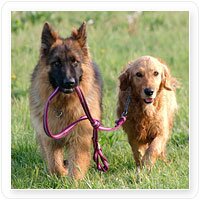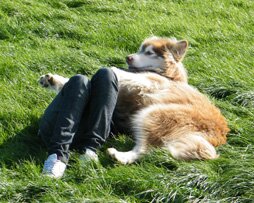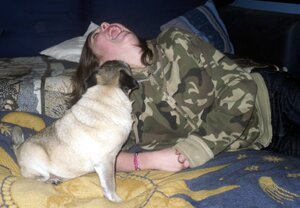|
|
|
|
|
|
|
The Dog Partnership:
|
| |
| 'He is your friend, your partner, your defender, your dog. You are his life, his love, his leader. He will be yours, faithful and true,to the last beat of his heart. You owe it to him to be worthy of such devotion' author unknown |
| |
| The Dog Partnership thinking focuses on the spirit of co-operation and friendship between dogs and people. It nurtures a harmonious relationship based on mutual trust and respect. |
|
|
|
|
| |
|
|
|
|
You wouldn’t dream of training your human friends. You make your opinions and feelings clear, and boundaries are established. You get on because you agree about what‘s right and what’s wrong.
You and your best friend understand each other perfectly without having to explain things to each other, because you know what each other is thinking. Our aim is for you to develop the same depth of friendship with your dog.
The Pleasure Principle
Of course dogs need to learn essential life skills, such an instant STOP and DOWN and COME for safety reasons.
But with a true friendship, many skills come naturally without training. Because just like human friends, your dog gets immense pleasure out of being your best friend.
|
|
|
|
|
A dog does not have to train another dog to follow or stay close to them. If your dog understands how valued a family member they are, you will have little need for training. It will become natural for them to follow you and stay within the family when you are out walking, as they would if they were with a group of dogs. 
For your dog to really feel a part of the family, you need to relate to them as you would any other family member. They should be fully included in family life. We often say our dogs are part of our family but do our dogs know this? If they are excluded from important family daily occurrences such as eating or sleeping, they can feel rejected and not a full family member. Does eating before your dog, show them that you are the family leader? No.
In a wild group of dogs, on returning from a hunt, the puppies greet the adults and demand food from them. The adults instinctively regurgitate the food for the puppies. The puppies are fed on demand but are not viewed as higher ranking than the adults because of this.
|
|
|
|
|
|
|
|
An important social event in any group of animals is to eat together. The alpha dog(s) eat the most highly valued and nutritious part of the animal, but they do not eat first and on their own. All group members eat together. Eating as a group is an extremely social and bonding activity.
|
|
|
|
This is the same with people. Even though family members may have their own individual lives, usually they meet to eat together; Sometimes in the evenings and sometimes at lunchtimes. Going out together with our friends and/or family is a highly valued social event. This is an activity that we all enjoy and brings us closer together as a unit. All family members usually attend this great social event and as a family member, this should include your dog.
|
|
|
|
 When you are having a meal, prepare some food for your dog as well. If it is your main meal of the day, give your dog their main meal of the day. If it is a snack, prepare your dog a snack, such as a hollow toy stuffed with some of their food. You may like to add a couple of extra tasty treats in the toy. When you are relaxing at home with your family try and encourage your dog to join you. If they choose to join you, that is even better. If possible, have physical contact with your dog; not all of the time otherwise you could make your dog over dependent on you. This is how a family group of dogs relax. It is how we relax with our family. When you are having a meal, prepare some food for your dog as well. If it is your main meal of the day, give your dog their main meal of the day. If it is a snack, prepare your dog a snack, such as a hollow toy stuffed with some of their food. You may like to add a couple of extra tasty treats in the toy. When you are relaxing at home with your family try and encourage your dog to join you. If they choose to join you, that is even better. If possible, have physical contact with your dog; not all of the time otherwise you could make your dog over dependent on you. This is how a family group of dogs relax. It is how we relax with our family.
Eating together, sleeping together and resting together are family bonding activities. We so often miss these opportunities to further develop our friendship with our dogs and reiterate how important they are within the family group. By involving your dog in family events you are conveying to them that whilst you are pleased when they respond to any request, they are also a highly valued member of the family. Show them by your expression that you recognise and appreciate their achievements. Show them how much you enjoy closeness with them.
|
|
|
|
|
|
|
Just for a moment, think about when you are feeling happy with your dog and think about why you are happy with them and in what way. |
|
|
|
|
|
|
How do you feel when your dog comes back when you call them or lies down when you ask them to?
|
|
|
|
Very pleased that they understood what you wanted and did it for you.
|
|
|
|
|
|
|
How do you show them that you are pleased they did what you asked?
|
|
|
|
‘Good Boy!’ and then maybe give them a treat. (Or if you use the clicker, a click followed by ‘Good Boy!’ and/or a treat.)
|
|
|
|
|
|
How do you feel when your dog comes back to you without you calling them?
|
|
|
This demonstrates that your dog wants to be with you. How wonderful does that feel?
|
|
|
|
|
|
How do you show them that you are really happy that they want to be with you?
|
|
|
Do you again say ‘Good Boy!’ and/or give them a treat? Usually we do.
|
|
|
|
|
|
How do you feel if your dog doesn’t react and looks to you if another dog rushes and barks at them?
|
|
|
Very proud and very impressed with your dog.
|
|
|
|
|
|
How do you show them how you feel about them ignoring the other dog?
|
|
|
Do you again say ‘Good Boy!’ and/or give them a treat. Often this is what we do.
|
|
|
|
|
|
But these are three different situations and whilst in each case you are pleased, you feel happy in different ways. Your dog needs to know these differences.
|
|
|

When your dog comes to you when you call them, they do it for you and not for themselves. This is a situation where praise and/or a treat is warranted.When they come to you of their own choosing they come to you for a different reason. It is the friendship between you that brings them back to you. They are happy to be with you and in themselves feel differently than if they came back when you called them. So do you. Show them this, by a smile and/or a greeting such as ‘Hi, I’m really happy to see you’. This is not a training situation. Don’t say ‘Good Boy!’ which implies to them that this is simply an exercise.
You would not praise a child for coming to you for a cuddle. You would usually respond by cuddling them and in doing so show them how much you care for them. You wouldn’t say ‘Good boy ’. You don’t need words at all. A smile or a hug says everything, in any language.When your dog does something that impresses you, such as ignoring a rabbit running across the path in front of them, show them how proud you are. ‘Wow!’ is a perfect word to use. In saying this you convey to your dog that you fully understand how difficult a situation they have been in and that you recognise their achievement.
|
|
|
Your dog watches and listens to you but above all, he relates to you intuitively, just as he does with his fellow canines. You listen to your friends, but above all you relate to them intuitively. This is a sign of a true friendship. You watch and listen to your dog, but should relate to them intuitively. This is a true Dog Partnership.
|
| |
|
| |
|
| |
|
|
|
|
What can influence a dog’s emotions?
|
|
1) Your emotions. e.g. Relaxed body posture and slow rhythmic breathing will encourage relaxation in the dog.
It is essential that you relax in a way that is natural to you personally; some people relax with their hands behind their heads, some across their chest and some with their arms alongside their body.
There are no rules. If the body posture is not natural to the person, it will not have a positive effect on the dog.
Slow rhythmic breathing accompanies any relaxing body posture.
|
|
|
2) A safe and controlled environment where the dog has the space and freedom to express his feelings and work through them.
In this environment, allow the dog to change his behaviour of his own volition. He will then learn for himself how changing his behaviour changes how he feels. The dog will recognise which behaviour creates a positive feeling and which behaviour creates a negative feeling.On this recognition, they actively choose the behaviour that creates the positive feeling. Thus the sociable behaviour itself is self-rewarding
|
|
|
|
|
 Problem Solving with The Dog Partnership Problem Solving with The Dog Partnership
History
Whilst history is interesting, it does not influence how you work with the dog today. Why the dog initially became aggressive can be considered during an assessment. But it is more important to assess and understand how they feel about their chosen coping strategy today.
For instance, if a dog was attacked at fourteen weeks then at that time they were probably terrified. By the time the dog reaches fourteen months, they will have developed their own coping strategy.
|
|
|
|
Self-Rewarding Behaviours

You can change a dog’s behaviour through training but that does not mean that you have changed how they feel. The dog alone has sole responsibility of their emotions.
You need to provide situations and environment where they can learn to take this responsibility. Giving the dog time and space to assess a perceived problem situation themselves, without human interference, will allow this to happen.
It has been said that if a person feels angry at something or someone, they are the only one who is suffering. This is because the feeling of anger is a negative emotion. If they learn how to control their anger, they will not experience this negative emotion. Thus, learning to take control of their emotions is self-rewarding. This also applies to dogs.
If they choose to drive the dog away by showing aggression, they will experience a sense of relief. It is the feeling of relief that reinforces this behaviour. There is no need for treats, toys or praise from the owner involved; it is a self-rewarding behaviour.
|
|
|
|
If provided with the right environment, the dog can learn that not showing aggression is a also self-rewarding behaviour; without the need for toys or treats or praise from the owner. You want your dog to stop any anti-social behaviour of their own volition thus learning how positive they feel for doing so.
The dog learns that the being aggressive is a negative feeling where as not being aggressive is a positive feeling. On realising this, most dogs choose the behaviour that creates the positive feeling – not being aggressive.
(There are, of course, always exceptions. Some dogs bred for fighting become over aroused the longer they are in an 'aggressive' situation. In this instance, a more structured approach may be needed.)
|
|
|
| |
The Next Step
It is essential that anyone working with aggression issues is skilled in reading dog communication. As the dog learns to control their emotions, their learning ability is enhanced. Situations are presented, in a safe environment, where there are other dogs and people.
When the dog has learns how to control their emotions, they are able to look at perceived threats in a calmer manner. Therefore, they can learn to overcome, through positive experience, that people and/or other dogs do not pose a threat to them or their family.
It is of paramount importance that they are able to read the very first signals of stress. Situations for learning have to be such that the dog does not become so stressed that they cannot learn. For instance, a dog with aggression towards other dogs may only be able to learn if the other dog is 20 metres away where others can cope if they are only ten metres away.
An in depth assessment of the dog’s general emotional state is essential before engaging in any rehabilitation programme. Many dogs will need a programme put into practice in the home to build self-confidence and feel more secure before presenting the problem situation.
|
| |
|
|
| |
What kind of relationship would you like with your dog?
Some people enjoy a friendship with a lot of physical interaction. A friendship where the ultimate pleasure is cuddling up on the sofa together.
Other people prefer a less intense friendship where general interaction is less physical. A friendship where the ultimate pleasure may be walking in open countryside for an afternoon.
|
|
| |
|
What kind of relationship would your dog like with you?
Some dogs enjoy a friendship with a lot of physical interaction. A friendship where the ultimate pleasure is cuddling up on the sofa together.
Other dogs may prefer a less intense friendship where general interaction is less physical. A friendship where the ultimate pleasure may be walking in open countryside for an afternoon.
|
| |
|
|
|
Mutual Respect and Trust |
| |
Dogs and people are the same where friendships are concerned. If you are living with a dog whose emotional needs are different from your own, it can be really difficult. It can cause communication breakdown between you, as with any relationship.
Your dog has no choice but to live with you. They cannot leave you because they need a different type of friendship. Therefore, as their guide and protector, it is your responsibility to consider their needs before your own.
|
|
|
Likewise with activities. You may enjoy Obedience but your dog may not. Your dog may enjoy Agility but you may not. In which case, partaking in either activity will do nothing to enhance your friendship. If anything it is likely to have a damaging effect on it.
If you take your partner shopping and they don’t want to go, by the end of the day, you are almost angry with each other. You can’t wait to spend time away from each other. The same principle applies to engaging in an activity that you or your dog does not enjoy. There are so many activities you can partake in with your dog. You just need to find an activity you both enjoy. Search and Rescue work is excellent.
In Search and Rescue you have to allow your dog to take control, as he has a better sense of smell than you. This can really enhance your friendship with your dog as you are showing them that you trust them. By giving your dog control of a situation and listening to them, you are also showing them respect. Respect and trust should be mutual between friends. Your dog is your friend and should be given the same consideration as any other friends.
|
|
|
|
|
|
The dog has all the answers; it is for you to find the right questions.
|
|
|
| |
|
|
|
|